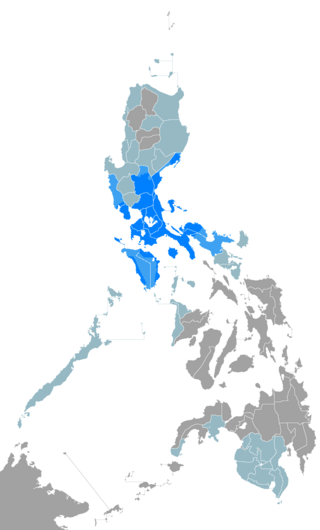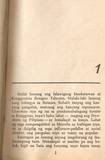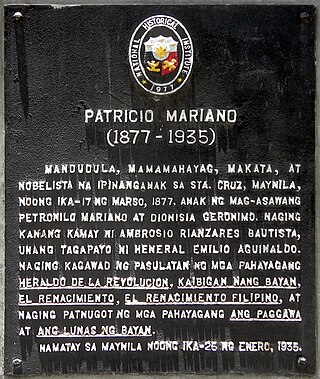
Tagalog is an Austronesian language spoken as a first language by the ethnic Tagalog people, who make up a quarter of the population of the Philippines, and as a second language by the majority. Its standardized form, officially named Filipino, is the national language of the Philippines, and is one of two official languages, alongside English.

The Katipunan, officially known as the Kataastaasan Kagalang-galang na Katipunan ng mga Anak ng Bayan and abbreviated as the KKK, was a revolutionary organization founded in 1892 by a group of Filipino nationalists Deodato Arellano, Andrés Bonifacio, Valentin Diaz, Ladislao Diwa, José Dizon, and Teodoro Plata. Its primary objective was achieving independence from the Spanish Empire through an armed revolution. It was formed as a secret society before its eventual discovery by Spanish authorities in August 1896. This discovery led to the start of the Philippine Revolution.
The 31st Don Carlos Palanca Memorial Awards for Literature was held to commemorate the memory of Don Carlos Palanca Sr. through an endeavor that would promote education and culture in the country.

Francisco Santiago Santiago was a Filipino musician, sometimes called The Father of Kundiman Art Song.

Alfonso Discher Tagle Sr., better known as Panchito Alba or simply Panchito, was a Filipino film actor who almost exclusively appeared in comedy roles. He was known for his swarthy looks and a prominent big nose, which was often the target of ridicule, especially Dolphy calling him "baboy ramo". Panchito frequently appeared as a comedic foil to Dolphy, with whom he was best friends in real life.

Lope K. Santos was a Filipino Tagalog-language writer and former senator of the Philippines. He is best known for his 1906 socialist novel, Banaag at Sikat and for his contributions to the development of Filipino grammar and Tagalog orthography.
Mga Ibong Mandaragit or Mga Ibong Mandaragit: Nobelang Sosyo-Politikal is a novel written by the Filipino writer and social activist, Amado V. Hernandez in 1969. Mga Ibong Mandaragit, hailed as Hernandez's masterpiece, focuses on the neocolonial dependency and revolt in the Philippines. The novel reflects Hernandez's experience as a guerrilla intelligence officer when the Philippines was under Japanese occupation from 1942 to 1945.

Lani Mercado-Revilla is a Filipino actress and politician serving as representative of Cavite's 2nd district, which comprises only the city of Bacoor, from 2010 to 2016.
Alejandro G. Abadilla, commonly known as AGA, was a Filipino poet, essayist, and fiction writer. Critic Pedro Ricarte referred to Abadilla as the father of modern Philippine poetry, and was known for challenging established forms and literature's "excessive romanticism and emphasis on rhyme and meter". Abadilla helped found the Kapisanang Panitikan in 1935 and edited a magazine called Panitikan. His Ako ang Daigdig collection of poems is one of his better-known works.

Satanas sa Lupa, subtitled “nobelang pangkasalukuyan”, is a 1970 Tagalog-language novel by Filipino author and scriptwriter Celso Al. Carunungan, one of the “titans of Philippine literature”. The novel criticizes the Philippine government and society during the early part of the 1970s, a reason why the author had been included among the group known as "Class 1081", Filipinos imprisoned when Martial Law was declared by Ferdinand Marcos in 1972.
Prudencio Baldivia, better known as Dencio Padilla or Tata Dens, was a veteran Filipino actor and comedian.
Ildefonso Santiago Santos was a Filipino educator, poet, and linguist. Recognized as one of the finest poets in Tagalog, Santos was also renowned with his translations of Rubaiyat of Omar Khayam and of the Philippine National Anthem, and for his use of the ancient Filipino form of poetry known as Tanaga.
Soledad Sarmiento Reyes is a Philippine literature scholar, literary and art critic, author, anthologist, consultant, professor, instructor, editor, annotator, researcher, and essayist in the Philippines. Specializing in the field of popular culture and the arts in the Philippines, Reyes is a professor teaching interdisciplinary studies at the University of the Philippines and the Ateneo de Manila University. She is an accomplished author of books and anthologies. "sa nobela mababalatuba ang mga pangyayati sa buhay ng isang kagawad sa union

Mga Anak-Bukid is a 1911 Tagalog-language novel written by Filipino novelist Rosauro C. Almario. Published by the Limbagang Cultura Filipina in Manila, Philippines, the novel narrates how the Filipinos who became the so-called pensionados undermined the traditional values and mores in the Philippines, including the people who acted as supporters and upholders of those conventional customs and norms.

Patricio Mariano y Geronimo, son of son of Petronilo Mariano and Dionisia Geronimo., was a Filipino nationalist, revolutionary, pundit, poet, playwright, dramatist, short story writer, novelist, journalist, violinist, painter, and a Katipunan member.

Juan Masili: Ang Pinuno ng Tulisan is a 1906 Tagalog-language novel written by Filipino novelist Patricio Mariano. Based on Project Gutenberg, the original format of the title of the novel was rendered as Juan Masili o Ang Pinuno ng Tulisan meaning "Juan Masili or The Leader of Bandits", therefore the title could stand alone either as Juan Masili or as Ang Pinuno ng Tulisan. The 24-page short novel was published in Manila, Philippines by Libreria Luzonica during the American era in Philippine history.

Anino ng Kahapon is a 1907 Tagalog-language novel written by Filipino novelist Francisco Laksamana. The 294-page novel was published in Manila by Santiago L. Abillar and SP during the first few years of American period in Philippine history. The 1907 version was illustrated by P Imperial. The novel was republished by the Ateneo de Manila University Press in 2002. According to the Ateneo de Manila University Press, the novel was written by Laksamana to help provide the readers with a "nostalgic recollection of the period of mournful Filipinoness". According to literary critic Epifanio San Juan, Jr. — apart from being a historical and political novel — Anino ng Kahapon was one of the romance novels and novels about heroic Philippine characters produced by Filipino authors from 1900 to contemporary times.

Ang mga Anak Dalita is a 1911 Tagalog-language novel written by Filipino novelist Patricio Mariano. The 73-page novel was published in Manila by Limbagan at Aklatan Ni I.R. Morales during the American era in Philippine history (1898–1946). Ang mga Anak Dalita is a political novel that deals also with Filipino ideology, the socio-economic situation, the industrial upheaval, and the struggle of the oppressed Filipino working class in Manila during Mariano’s time.
Ang Lihim ng Isang Pulo: Nobelang Tagalog – "The Secret of an Island: A Tagalog Novel " – is a Tagalog-language novel written in 1926 by Filipino novelist Faustino S. Aguilar. The 353-page novel was first published by Sampaguita Press in the Philippines in 1927. It was republished in Manila by Benipayo Press in 1958.
Lumbay ng Dila is a novel written by Filipino author Genevieve L. Asenjo published in 2010. The novel is set mainly in Antique in the Western Visayas region of the Philippines and it tells the story of Sadyah Zapanta – Lopez. It received a special citation for Excellence in Fiction in a Philippine Language in the Juan C. Laya Prize in the 2011 Philippine National Book Awards.












